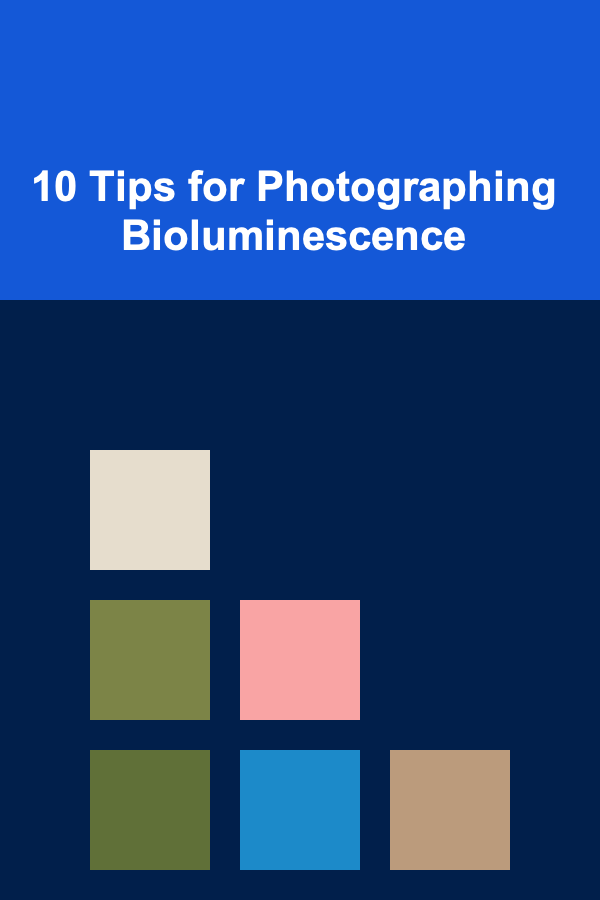
10 Tips for Photographing Bioluminescence
ebook include PDF & Audio bundle (Micro Guide)
$12.99$11.99
Limited Time Offer! Order within the next:

Photographing bioluminescence can be one of the most magical and rewarding experiences for nature photographers. Whether it's glowing plankton in the ocean, bioluminescent fungi in the forest, or fireflies lighting up a warm summer night, capturing these natural light displays requires skill, preparation, and the right equipment. Bioluminescence itself is fascinating: it occurs when living organisms produce and emit light, often as a result of chemical reactions within their bodies.
To help you achieve stunning photos of this phenomenon, we've compiled 10 essential tips that cover everything from technique and equipment to timing and location. By understanding the unique challenges and opportunities presented by bioluminescence, you'll be better equipped to photograph these stunning moments in the natural world.
Understand the Science Behind Bioluminescence
Before you even step out with your camera, it's essential to understand the science behind bioluminescence. Knowing how it works can help you make better decisions about how to photograph it.
Bioluminescence is produced by organisms that use chemical reactions within their bodies. This light is usually a result of the enzyme luciferase breaking down luciferin molecules in the presence of oxygen, creating light as a byproduct. The intensity, color, and frequency of bioluminescence vary depending on the organism.
For example:
- Marine plankton often produce a blue glow in the water when disturbed.
- Fireflies typically produce a steady yellow, green, or orange glow.
- Bioluminescent fungi often glow in greenish hues, especially in humid environments.
Knowing what causes the light and how intense it might be will help you predict the best settings and equipment for your shoot.
Choose the Right Time and Location
Timing is everything when photographing bioluminescence. These organisms typically glow in response to specific conditions or behaviors, so understanding when and where to photograph is key to capturing them.
Best Time
- Nighttime: Bioluminescence is most visible at night when the surrounding darkness allows the glow to stand out. The darker the environment, the more the bioluminescence will appear.
- During peak activity: Many bioluminescent organisms light up during specific times of the year or night. For example, fireflies have mating seasons, while bioluminescent plankton are often more active on warm nights after storms.
Ideal Locations
- Coastal waters: Bioluminescent plankton thrive in warm, nutrient-rich coastal waters, and some beaches around the world offer opportunities to witness glowing shorelines or glowing waves.
- Forests and jungles: Bioluminescent fungi can be found in damp, humid forests, especially in tropical regions. Fireflies are commonly seen in temperate areas, often in forests or meadows.
- Caves: Some caves have bioluminescent organisms on their walls, creating a surreal effect when photographed.
Researching the best locations, understanding local species, and planning your shoot around the organisms' natural behaviors will increase your chances of a successful shoot.
Use a Tripod for Stability
Bioluminescent subjects are often very dim, and capturing them effectively requires long exposure times. To avoid camera shake and ensure that your shots are sharp, always use a tripod when photographing bioluminescence. This will help keep your camera steady during long exposures, allowing more light to hit the sensor and preserving the delicate glow.
Make sure your tripod is sturdy, especially when shooting in locations like the beach, where wind or uneven terrain can cause instability. A flexible tripod may also help when shooting in tight or uneven areas, such as forests or caves.
Shoot in Manual Mode
To get the best results when photographing bioluminescence, it's important to take full control over your camera settings. This allows you to adjust exposure and focus according to the unique lighting conditions. Set your camera to manual mode to control the shutter speed, aperture, and ISO individually.
Key Settings:
- Shutter Speed : Use long exposure times to capture the faint glow of bioluminescent organisms. Exposure times of 5 to 20 seconds work well, but you may need to experiment based on the intensity of the bioluminescence and the environment.
- Aperture : A wide aperture (low f-number) such as f/2.8 or f/4 allows more light to hit the sensor, helping to brighten up the glow of the bioluminescence.
- ISO : Since bioluminescence can be faint, you may need to increase your ISO to make sure the camera sensor captures enough light. Start at ISO 800 or 1600, and increase it if needed, but be mindful of noise.
Use a Wide-Angle Lens
A wide-angle lens is perfect for capturing the vastness and beauty of bioluminescent scenes, especially when you want to showcase the glow in relation to the surroundings. For marine bioluminescence, for example, a wide-angle lens can help you capture the glowing water and the starry sky above.
A lens with a focal length between 14mm and 35mm is ideal for this type of photography. This allows you to capture more of the scene and gives you the flexibility to photograph landscapes as well as close-ups.
Embrace Long Exposures
When photographing bioluminescence, a long exposure time is often necessary to capture enough light. The organisms' glow is usually faint and brief, so keeping the shutter open for an extended period will give the camera enough time to gather light.
Long exposure photography also adds an ethereal quality to your images, allowing moving elements like glowing water or fireflies to leave trails of light across the frame. This is particularly striking in bioluminescence photography, as the movement of the organisms will create a soft, almost dreamlike effect.
Be mindful of overexposure, as this can make the bioluminescence too bright and diffuse. Start with exposure times of 10--20 seconds and adjust based on the glow's intensity and the amount of ambient light.
Avoid Light Pollution
To truly capture the magic of bioluminescence, it's essential to shoot in a location with minimal light pollution. Light from street lamps, vehicles, or nearby towns can overpower the bioluminescence and make it difficult to capture.
Plan your shoot in areas far from city lights and artificial illumination. If you're shooting in a natural setting, consider the moon phase as well---on a moonless night, the darkness will enhance the bioluminescence, making it stand out more.
Be Patient and Ready to Experiment
Bioluminescence is often unpredictable, which means you need to be patient and adaptable. Bioluminescent organisms might not always behave as expected, and their glow may vary in intensity depending on environmental factors such as water temperature, humidity, and air conditions.
Prepare to experiment with different exposure times, camera settings, and compositions until you capture the perfect shot. Bioluminescent photography is not always something you can "force," so it's essential to give yourself the time and flexibility to capture the magic when it happens.
Use Remote Shutter Release or Timer
When shooting with long exposures, even the smallest movement can lead to blurry images. To avoid camera shake, use a remote shutter release or set your camera's self-timer to take the photo without you physically pressing the shutter button. This minimizes the chance of any vibrations affecting your shot.
Remote shutter releases are inexpensive accessories that connect to your camera and allow you to trigger the shutter from a distance. If you don't have one, setting a timer on your camera will work just as well.
Post-Processing for the Final Touch
Post-processing is crucial to bringing out the full beauty of your bioluminescence shots. Use software like Adobe Lightroom or Photoshop to adjust the exposure, contrast, and color balance. Here are some key adjustments to make:
- Increase Contrast: This will help the glow stand out against the dark surroundings.
- Reduce Noise: Bioluminescent photography often requires high ISO, which can introduce noise into your images. Use noise reduction tools to clean up your photos without losing too much detail.
- Enhance Colors: Sometimes, bioluminescent glow can appear flat in photographs. Enhance the blues, greens, or yellows to make the glow more vibrant and striking.
Bonus Tip: Experiment with Different Angles and Compositions
Take time to experiment with different compositions. Whether it's photographing the shoreline lit by bioluminescent plankton, close-ups of glowing mushrooms, or wide shots of fireflies lighting up a meadow, each scene can look different based on the angle and perspective you choose.
Try using foreground elements like trees, rocks, or water to create depth in your shot, and look for patterns or movement that will add to the overall composition.
Conclusion
Photographing bioluminescence is an incredible challenge, but with the right knowledge, preparation, and techniques, you can capture stunning, magical images. By understanding the science behind bioluminescence, choosing the right time and location, and utilizing specific camera settings, you can photograph these phenomena in all their glowing glory. Remember to be patient, experiment, and embrace the unique nature of these natural light shows. With practice, you'll be able to document the mesmerizing beauty of bioluminescent organisms in their full, radiant splendor.
Reading More From Our Other Websites
- [Organization Tip 101] How to Create a Vision Board for Your Time Management Goals
- [Organization Tip 101] How to Organize Tools by Frequency of Use
- [Home Space Saving 101] How to Use Wall-Mounted Storage to Save Floor Space
- [Personal Investment 101] How to Profit from Building Deep Learning-Based Software Products
- [Home Renovating 101] How to Transform Your Bathroom with Simple Renovation Ideas
- [Home Maintenance 101] How to Clean Your Chimney and Prevent Fire Hazards
- [Trail Running Tip 101] Footwear Showdown: Selecting the Ideal Shoes for Trail and Road Runners
- [Organization Tip 101] How to Create a Maintenance Calendar for Appliances
- [Home Maintenance 101] How to Care for Hardwood Floors and Keep Them Looking New
- [Simple Life Tip 101] Best Simple‑Life Fitness Routines That Require No Gym Membership

How to Make Your Home Safe for Pets: Essential Safety Tips
Read More
How to Use Multi-Functional Furniture for Extra Storage Space
Read More
The Step-by-Step Guide to Screenwriting
Read More
Incorporating Hand and Foot Care into Your Routine: A Comprehensive Guide
Read More
10 Tips for Litter Box Training: A Cat Training Checklist
Read More
10 Tips for Budgeting Your Quilting Supplies
Read MoreOther Products

How to Make Your Home Safe for Pets: Essential Safety Tips
Read More
How to Use Multi-Functional Furniture for Extra Storage Space
Read More
The Step-by-Step Guide to Screenwriting
Read More
Incorporating Hand and Foot Care into Your Routine: A Comprehensive Guide
Read More
10 Tips for Litter Box Training: A Cat Training Checklist
Read More